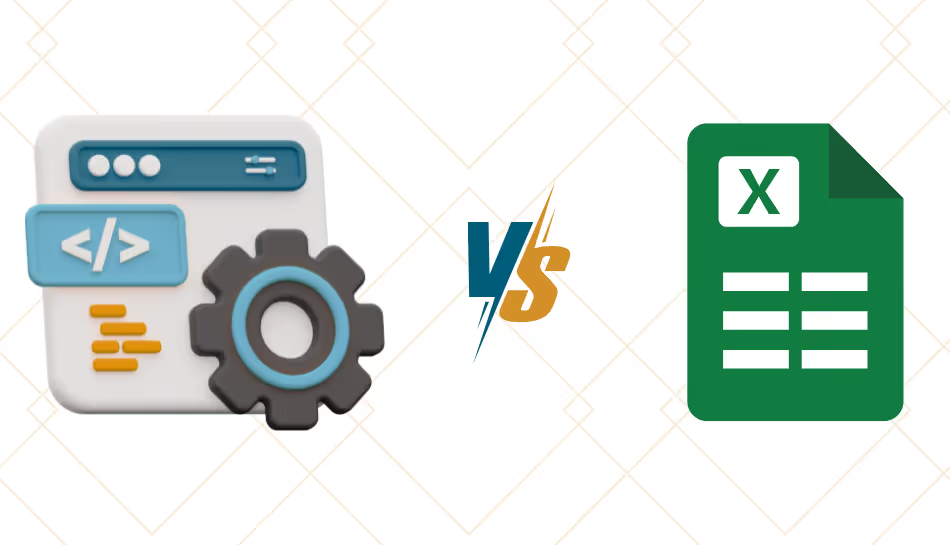For most manufacturers, Microsoft Excel has been the tried-and-true application for handling production scheduling, inventory, and accounting data. It's versatile, comfortable, and low-cost. Yet as operations expand and supply networks get more complicated, Excel starts to reveal its shortcomings. That's when ERP software steps in. In ERP vs Excel for manufacturing, the distinction is in scalability, precision, and real-time insight.
Let's discuss why ERP is superior to Excel, the limitations of using Excel in the manufacturing sector, and what companies have to gain by making a transition from Excel to ERP.
Excel Limitations in the Manufacturing Sector
Excel is a great place for small-scale manufacturers to start, but managing it becomes really tough as the business grows. Some of the most important Excel limitations in the manufacturing sector are:
- Data Inconsistency
Many iterations of the same spreadsheet exist across departments. Without control at the center, data is inconsistent and outdated. - No Real-Time Updates
Production depends greatly on minute-by-minute data for materials, production, and delivery. Excel does not update real-time, so teams will be working with outdated information. - Error-Ridden Calculations
One misplaced formula or manual entry can disrupt whole production or costing plans. The greater the dataset, the greater the potential for human error. - No Integration with Other Systems
Excel does not talk to procurement, sales, or accounting applications. This creates siloed workflows and decision delays. - Limited Collaboration
Sharing spreadsheets across various users can lead to version conflict or data overwrite, particularly when multiple individuals update them at the same time.
These constraints render Excel unfit for manufacturers seeking to expand operations cost-effectively.
Why ERP is Superior to Excel
Now let us discuss why ERP is superior to Excel for manufacturers. ERP (Enterprise Resource Planning) software encompasses all departments, production, inventory, finance, sales, and supply chain, into one integrated system.
Here's what ERP offers:
- Centralized and Real-Time Data
ERP stores data in a single location so all teams have access to correct, current information. If raw material inventory is changed, for example, production and procurement know immediately. - Automatic Processes
ERP automated processes such as tracking orders, managing inventory, and planning production. It minimizes manual labor and eliminates redundant data entry. - Better Forecasting and Planning
With integrated analytics, ERP systems enable manufacturers to forecast demand, plan production schedules, and allocate resources more effectively. - Better Compliance and Traceability
Producers have to frequently adhere to quality and regulatory requirements. ERP keeps tabs on every step of production, making everything transparent and audit-ready. - Scalability and Integration
As companies grow, ERP seamlessly integrates new departments, warehouses, or products without affecting current operations.
Simply put, while Excel tracks data, ERP manages whole operations.
Moving from Excel to ERP
It seems daunting to shift from Excel to ERP, but the gains in the long term are much greater than the toil. Here's what it takes to switch over from Excel to ERP:
- Data Migration – The current Excel data is sanitized and migrated into the ERP environment.
- Customization – The ERP modules are set up to align with the manufacturer's operations, from production to sales.
- Training – Staff are trained to utilize the new system effectively.
- Automation Setup – Core processes like order approvals and inventory updates are automated.
- Go-Live and Monitoring – The system is tested and implemented with constant support.
After implementing ERP, manufacturers see instant benefits in productivity, accuracy, and collaboration.
ERP Software vs Excel Sheets: The Final Verdict
In comparing ERP software and Excel spreadsheets, it is easy to see the difference. Excel can handle data but ERP handles the business. Companies that use only Excel encounter increasing inefficiencies as they grow their operations, whereas ERP provides accuracy, speed, and visibility at all levels.
Final Thoughts
In the world of rapid manufacturing, real-time knowledge and automation are crucial. Excel can be used for small operations but cannot handle intricate production networks or supply chains. The move to ERP is not an upgrade, it's a revolution.
By adopting ERP for manufacturing, organizations can cut data silos, enhance planning, and grow with confidence for the future. In short, in the context of ERP vs Excel for manufacturing, ERP is the wiser, more efficient option.



